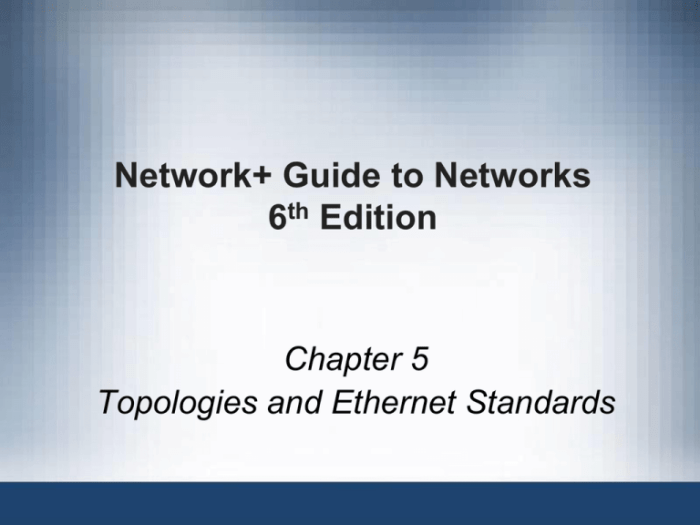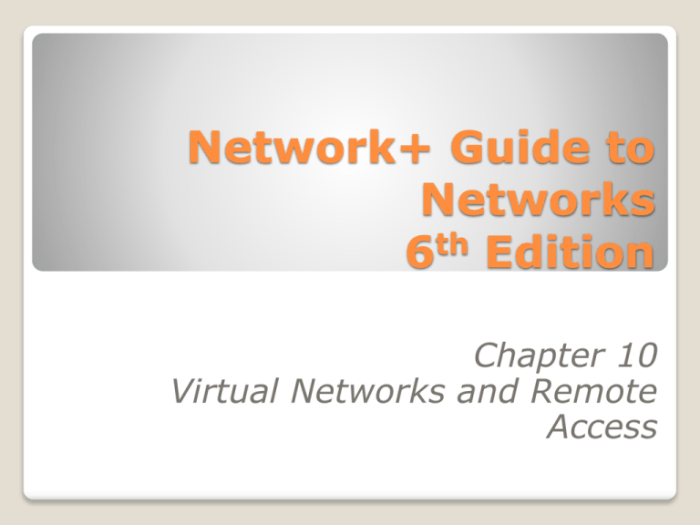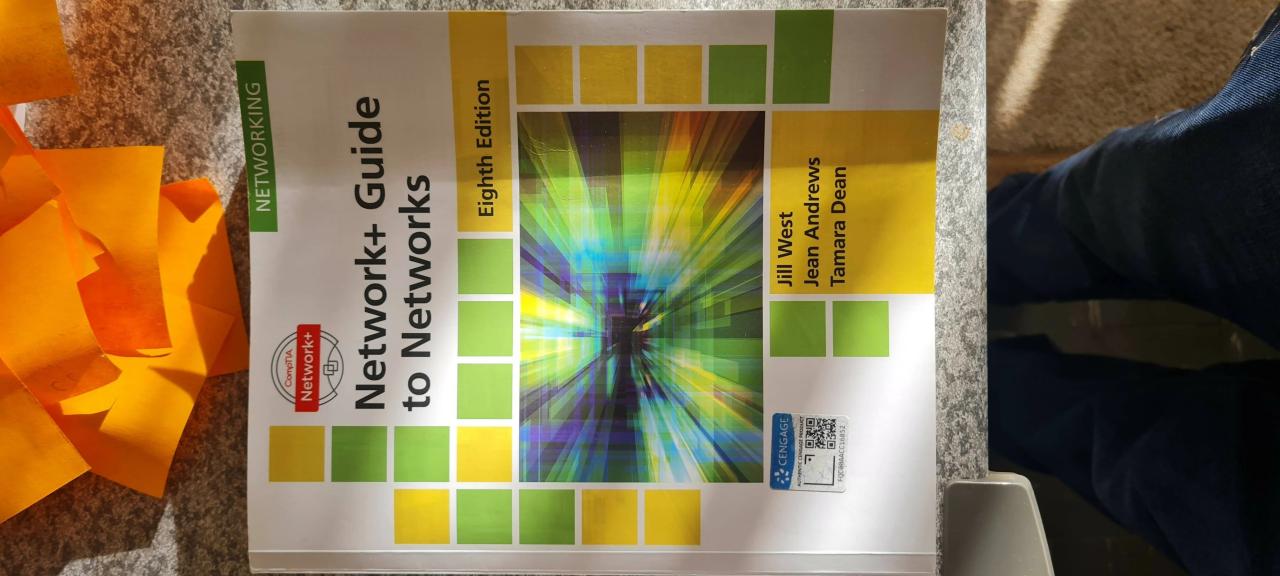Network+ guide to networks 8th edition – Delve into the comprehensive world of networking with the Network+ Guide to Networks, 8th Edition. This authoritative resource provides a comprehensive exploration of network fundamentals, topologies, protocols, media, devices, security, management, and emerging technologies, empowering you to navigate the complexities of modern networks.
As you journey through this guide, you’ll gain a deep understanding of the foundational concepts of networking, including the OSI model and its layers. You’ll explore various network topologies and protocols, gaining insights into their functions and applications. Furthermore, you’ll delve into the intricacies of network media and cabling, understanding their types, standards, and advantages.
1. Network Fundamentals
Networking is the interconnection of computer systems and devices that enables data exchange and resource sharing. It consists of hardware, software, and protocols that facilitate communication and collaboration within a network.
Types of networks include:
- Local Area Network (LAN): A network confined to a small geographic area, such as a building or office.
- Wide Area Network (WAN): A network that spans a large geographic area, connecting devices over long distances.
- Metropolitan Area Network (MAN): A network that covers a metropolitan area, such as a city or town.
The OSI (Open Systems Interconnection) model is a conceptual framework that describes the different layers of networking. Each layer provides specific functions and services, such as data encapsulation, addressing, and error detection.
OSI Model Layers
- Physical Layer: Transmits raw data bits over the network medium.
- Data Link Layer: Encapsulates data into frames and provides error control.
- Network Layer: Provides routing and addressing for data packets.
- Transport Layer: Ensures reliable and efficient data delivery.
- Session Layer: Establishes, manages, and terminates communication sessions.
- Presentation Layer: Translates data into a common format.
- Application Layer: Provides user-specific services, such as file transfer and email.
2. Network Topologies and Protocols: Network+ Guide To Networks 8th Edition

Network topologies define the physical arrangement of network devices. Common topologies include:
- Bus Topology: Devices are connected to a single shared transmission medium.
- Ring Topology: Devices are connected in a circular loop, with data flowing in one direction.
- Star Topology: Devices are connected to a central hub or switch.
Network protocols define the rules and procedures for communication over a network. They include:
- TCP (Transmission Control Protocol): Provides reliable, connection-oriented data transfer.
- UDP (User Datagram Protocol): Provides unreliable, connectionless data transfer.
- HTTP (Hypertext Transfer Protocol): Used for web browsing.
- SMTP (Simple Mail Transfer Protocol): Used for email.
3. Network Media and Cabling

Network media transmit data signals between devices. Types of media include:
- Twisted Pair Cable: Consists of two insulated copper wires twisted together.
- Coaxial Cable: A single copper conductor surrounded by insulation and a metal shield.
- Fiber Optic Cable: Uses light to transmit data over thin glass or plastic strands.
Network cabling standards define the specifications for cables and connectors. Common standards include:
- Cat5e: Used for Ethernet networks with speeds up to 1000 Mbps.
- Cat6: Used for Ethernet networks with speeds up to 10 Gbps.
- Fiber Optic: Used for high-speed networks with low latency.
Advantages and Disadvantages of Cabling Types, Network+ guide to networks 8th edition
| Type | Advantages | Disadvantages |
|---|---|---|
| Twisted Pair | Low cost, easy to install | Limited bandwidth, susceptible to interference |
| Coaxial | Higher bandwidth than twisted pair | More expensive, difficult to install |
| Fiber Optic | Highest bandwidth, low latency | Most expensive, requires specialized equipment |
4. Network Devices

Network devices facilitate data transmission and network management. Types of devices include:
- Routers: Connect different networks and determine the best path for data packets.
- Switches: Connect devices within a network and forward data frames.
- Hubs: Connect multiple devices and broadcast data to all connected devices.
Network devices can be configured and managed using various tools and techniques. Common management protocols include:
- SNMP (Simple Network Management Protocol): A standard protocol for monitoring and managing network devices.
- Telnet: A command-line interface for remote access to network devices.
- SSH (Secure Shell): A secure protocol for remote access to network devices.
5. Network Security
Network security is crucial for protecting networks from unauthorized access, data breaches, and cyberattacks. Threats include:
- Malware: Malicious software that can damage or steal data.
- Phishing: Attempts to trick users into revealing sensitive information.
- Hacking: Unauthorized access to networks and systems.
Network security measures include:
- Firewalls: Blocks unauthorized access to networks.
- Intrusion Detection Systems (IDS): Monitors network traffic for suspicious activity.
- Virtual Private Networks (VPNs): Encrypts data traffic for secure remote access.
6. Network Management
Network management involves monitoring, maintaining, and troubleshooting networks. Principles include:
- Performance Monitoring: Tracking network performance and identifying bottlenecks.
- Fault Detection: Identifying and resolving network problems.
- Configuration Management: Ensuring that network devices are properly configured.
Network management tools include:
- Network Management Systems (NMS): Centralized platforms for managing multiple network devices.
- Network Monitoring Tools: Monitors network traffic and performance.
- Packet Analyzers: Captures and analyzes network packets for troubleshooting.
7. Emerging Network Technologies

Emerging network technologies include:
- Software-Defined Networking (SDN): Decouples network control from hardware, allowing for more flexible and programmable networks.
- Network Function Virtualization (NFV): Virtualizes network functions, such as firewalls and load balancers, improving scalability and agility.
- 5G: The fifth generation of cellular technology, providing ultra-fast speeds and low latency.
These technologies have the potential to transform networks, enabling new applications and services.
Questions and Answers
What is the significance of the OSI model in networking?
The OSI model provides a conceptual framework for understanding network communication, dividing it into seven layers, each with specific functions and responsibilities.
What are the key differences between network topologies?
Network topologies vary in their physical arrangement of devices, such as bus, star, ring, and mesh, each with its own advantages and disadvantages.
How do network protocols facilitate communication?
Network protocols define rules and standards for data transmission, ensuring compatibility and interoperability between devices and applications.